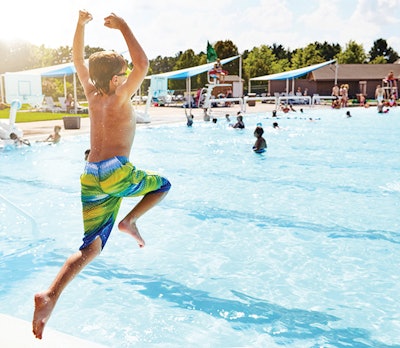
Proper sanitation helps keep pools free of microorganisms that can lead to and cause waterborne illnesses. Traditionally, the primary source of sanitation has been a halogen (chlorine or bromine). We are now finding that certain halogen-tolerant pathogens, such as Cryptosporidium, require the use of an additional means to disinfect pools.
This article focuses on secondary and supplemental treatment equipment used in commercial pools as defined by ANSI/APSP/ICC-11 American National Standard for Water Quality in Public Pools and Spas.
SECONDARY SYSTEMS
The difference between secondary and supplemental systems is that secondary disinfection systems are required for increased-risk aquatic venues, while supplemental treatment systems are not required, but may be used to improve water quality and/or enhance overall system performance. Both systems require the use of a primary disinfecting halogen, such as chlorine or bromine.
RELATED: Pool Sanitizing: A Return to the Simple
Secondary disinfection systems are designed to achieve a minimum 3-log (99.9%) reduction in the number of infective Cryptosporidium parvum oocysts and other pathogenic microorganisms per pass through the secondary disinfection system at the maximum flow rate.
These systems are listed and labeled to NSF/ANSI Standard 50 Equipment for Swimming Pools, Spas, Hot Tubs and Other Recreational Water Facilities by an American National Standards Institute (ANSI)-accredited certification organization and installed according to the manufacturer’s directions. When listed as an NSF-approved system, it is classified as a sanitizer.
Increased-risk aquatic venues have a higher probability of microbial contamination due to their primary users being children under the age of 5 and/ or people more susceptible to infection, such as therapy patients with open wounds. According to the standard, all new construction or substantial alteration of the following increased-risk aquatic venues are required to use a secondary disinfection system:
- Wading pools
- Interactive water play venues
- Other aquatic venues designed primarily for children under the age of 5
- Therapy pools
Secondary disinfection systems may be installed on other aquatic venues as well. At present, secondary disinfection systems are either ozone or ultraviolet (UV) light systems.
RELATED: How to Decontaminate Spas and Kiddie Pools
SUPPLEMENTAL SYSTEMS
Supplemental treatment systems are designed to enhance water quality, but not required to achieve the minimum 3-log (99.9%) reductions of secondary disinfection systems. Secondary treatment systems (such as ozone or UV) can also be considered supplemental systems when they are not required at an increased-risk venue.
Metal ion-based systems are often used as supplemental treatment systems.
OZONE SECONDARY DISINFECTION SYSTEMS
Ozone systems depend on an oxidation reaction, which occurs once ozone has been dissolved in water. Once this reaction takes place, organic contaminants are destroyed, and many dissolved metals become insoluble.
Ozone is capable of killing all known microorganisms (including Cryptosporidium and Giardia), destroying organic contaminants that may create chloramines and breaking down existing chloramines. This oxidation occurs immediately at the ozone gas injection point and continues in the return lines. A small residual (approximately 0.1 ppm) of dissolved ozone may enter the pool, providing further oxidation.
RELATED: Source Water and its Effects on Pool and Spa Maintenance
An ozone-generating system is considered a pesticidal device under the U.S. EPA Federal Insecticide, Fungicide, and Rodenticide Act (FIFRA) and has an EPA Establishment number.
Commercial ozone-generating systems are tested and listed under NSF/ANSI Standard 50. The device must meet the requirements of NSF 50, Disinfection Efficacy in Section 14.20 and must be used with an EPAregistered sanitizer to impart residual concentrations in accordance with federal, state or local regulations. The use of secondary systems in combination with a primary halogen should be used in accordance with manufacturer’s recommendations.
UV SECONDARY DISINFECTION SYSTEMS
UV light systems use a process known as “Photolysis” to inactivate microorganisms (including Cryptosporidium and Giardia). The intensity of the lamp and the flow rate through the unit will produce a “dosage” measured in mJ/cm3. UV light is most effective at a known wavelength of 254 nm. Commercial ultraviolet light systems are tested and listed under NSF/ANSI Standard 50. The device must meet the requirements of NSF 50, Disinfection Efficacy, in Section 14.20 and must be used with an EPA-registered sanitizer to impart residual concentrations in accordance with federal, state or local regulations.
UV AND OZONE SUPPLEMENTAL SYSTEMS
Both ozone and UV systems can also be used as supplemental treatment systems to enhance both water and indoor air quality. Air quality has become critical in protecting swimmers, pool attendants, spectators or anyone spending time in an indoor pool environment. Both UV light and ozone systems have been proven to be effective in destroying chloramines in swimming pools and therefore improving indoor air quality.
Supplemental systems in combination with a primary halogen should be used in accordance with manufacturer’s recommendations.
METAL-BASED SYSTEMS
While metal-based systems have been recognized as EPA-registered sanitizer systems when used with a primary halogen, the metal ionizer component has always served as a supplemental treatment system to the halogen.











































